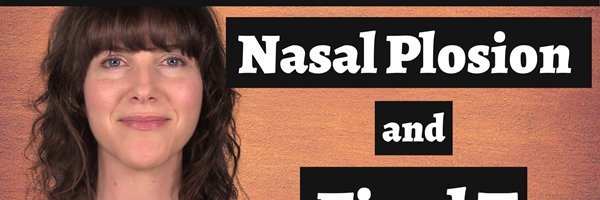(Video Transcript)
Hi, I’m Julie with San Diego Voice and Accent, and in this video you’ll learn how to pronounce words with nasal plosion.
Have you heard of nasal plosion before? If not, that’s OK because nasal plosion is a more advanced feature of American English pronunciation. But if you learn how to use it, you will sound much more natural to a native speaker.
How to pronounce the word sudden
So, here it is. I’m going to pronounce this word using nasal plosion.
Sudden
I’ll say it again, and listen to how I pronounce the last syllable.
Sudden
Many of my accent clients pronounce this word as sudden, sudden, sudden, using a released D, then pronouncing the IH vowel, and then the N consonant.
Sudden
But native speakers may use nasal plosion in that final syllable. Instead of saying din in the final syllable, native speakers may use an unreleased D, omit the vowel completely, and then move from the unreleased D to a syllabic N consonant.
Sudden
How to pronounce nasal plosion in American English
Here’s how you produce nasal plosion. Place the front of the tongue at the alveolar ridge for the D consonant, then keep the tongue up and lower the soft palate for the N consonant. You might not know how to lower the soft palate, so if that’s confusing, just focus on going directly from the D to the N without moving the tongue.
Sudden
Nasal plosion can occur in words that have a final unstressed D + N combination, like in:
Widen
Hidden
Garden
Burden
Forbidden
Nasal plosion and stop T + syllabic N
The rules for nasal plosion are very similar to the rules for when to use a stop T and a syllabic N, like in the word button.
In button, the final syllable contains a final, unstressed T plus N combination. And notice how the T consonant changes to a stop T, the vowel is omitted, and then you move directly from the stop T to a syllabic N consonant.
Listen to the similarities between nasal plosion and a stop T plus syllabic N combination:
Sudden
Button
Sudden
Button
In both cases, the D or T in the final syllable is changed. The D turns into an unreleased D, and the T changes into a stop T. The vowel in the final syllable is omitted, and the N turns into a syllabic consonant.
Practice: Nasal plosion
Let’s practice nasal plosion. I’ll say the word three times, and then you’ll have a chance to repeat. Then I’ll say the sentence once, and you’ll have a chance to repeat.
Sudden
It was all so sudden.
Widen
The citizens want to widen the highway.
Hidden
The eggs were hidden from the children.
Garden
I grow vegetables in my garden.
Burden
It was a huge burden, but I did it.
I hope this video helped you to understand how to use nasal plosion in American English. Thanks for watching! And I'd love to hear from you - contact me to learn how we can work together to perfect your American English pronunciation!



